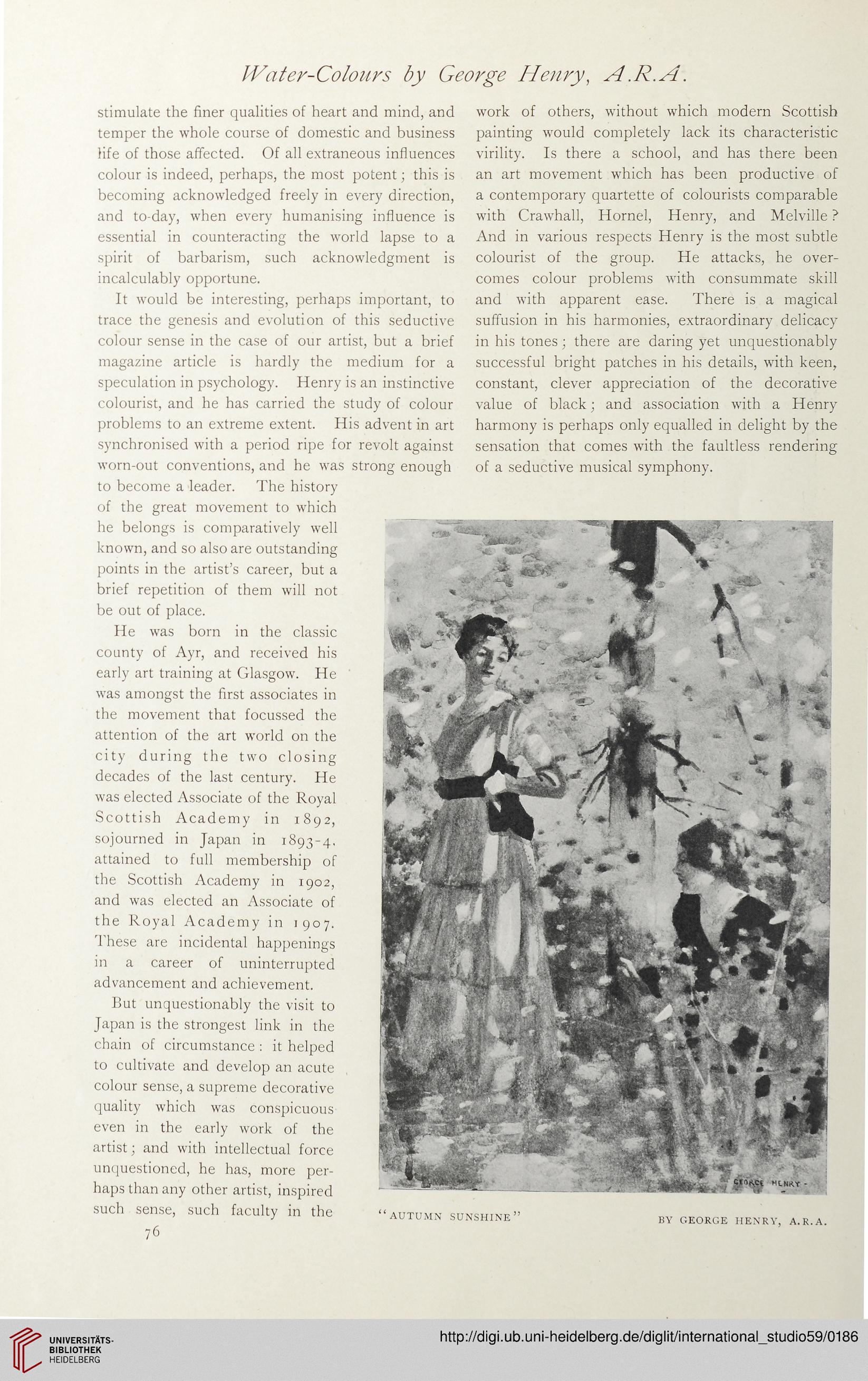Water-Colours by George Henry, A.R.A.
stimulate the finer qualities of heart and mind, and
temper the whole course of domestic and business
fife of those affected. Of all extraneous influences
colour is indeed, perhaps, the most potent; this is
becoming acknowledged freely in every direction,
and to-day, when every humanising influence is
essential in counteracting the world lapse to a
spirit of barbarism, such acknowledgment is
incalculably opportune.
It would be interesting, perhaps important, to
trace the genesis and evolution of this seductive
colour sense in the case of our artist, but a brief
magazine article is hardly the medium for a
speculation in psychology. Henry is an instinctive
colourist, and he has carried the study of colour
problems to an extreme extent. His advent in art
synchronised with a period ripe for revolt against
worn-out conventions, and he was strong enough
to become a leader. The history
of the great movement to which
he belongs is comparatively well
known, and so also are outstanding
points in the artist’s career, but a
brief repetition of them will not
be out of place.
He was born in the classic
county of Ayr, and received his
early art training at Glasgow. He
was amongst the first associates in
the movement that focussed the
attention of the art world on the
city during the two closing
decades of the last century. He
was elected Associate of the Royal
Scottish Academy in 1892,
sojourned in Japan in 1893-4,
attained to full membership of
the Scottish Academy in 1902,
and was elected an Associate of
the Royal Academy in 1907.
These are incidental happenings
in a career of uninterrupted
advancement and achievement.
But unquestionably the visit to
Japan is the strongest link in the
chain of circumstance : it helped
to cultivate and develop an acute
colour sense, a supreme decorative
quality which was conspicuous
even in the early work of the
artist; and with intellectual force
unquestioned, he has, more per-
haps than any other artist, inspired
such sense, such faculty in the
76
work of others, without which modern Scottish
painting would completely lack its characteristic
virility. Is there a school, and has there been
an art movement which has been productive of
a contemporary quartette of colourists comparable
with Crawhall, Hornel, Henry, and Melville ?
And in various respects Henry is the most subtle
colourist of the group. He attacks, he over-
comes colour problems with consummate skill
and with apparent ease. There is a magical
suffusion in his harmonies, extraordinary delicacy
in his tones; there are daring yet unquestionably
successful bright patches in his details, with keen,
constant, clever appreciation of the decorative
value of black; and association with a Henry
harmony is perhaps only equalled in delight by the
sensation that comes with the faultless rendering
of a seductive musical symphony.
“autumn sunshine
BY GEORGE HENRY, A.R.A.
stimulate the finer qualities of heart and mind, and
temper the whole course of domestic and business
fife of those affected. Of all extraneous influences
colour is indeed, perhaps, the most potent; this is
becoming acknowledged freely in every direction,
and to-day, when every humanising influence is
essential in counteracting the world lapse to a
spirit of barbarism, such acknowledgment is
incalculably opportune.
It would be interesting, perhaps important, to
trace the genesis and evolution of this seductive
colour sense in the case of our artist, but a brief
magazine article is hardly the medium for a
speculation in psychology. Henry is an instinctive
colourist, and he has carried the study of colour
problems to an extreme extent. His advent in art
synchronised with a period ripe for revolt against
worn-out conventions, and he was strong enough
to become a leader. The history
of the great movement to which
he belongs is comparatively well
known, and so also are outstanding
points in the artist’s career, but a
brief repetition of them will not
be out of place.
He was born in the classic
county of Ayr, and received his
early art training at Glasgow. He
was amongst the first associates in
the movement that focussed the
attention of the art world on the
city during the two closing
decades of the last century. He
was elected Associate of the Royal
Scottish Academy in 1892,
sojourned in Japan in 1893-4,
attained to full membership of
the Scottish Academy in 1902,
and was elected an Associate of
the Royal Academy in 1907.
These are incidental happenings
in a career of uninterrupted
advancement and achievement.
But unquestionably the visit to
Japan is the strongest link in the
chain of circumstance : it helped
to cultivate and develop an acute
colour sense, a supreme decorative
quality which was conspicuous
even in the early work of the
artist; and with intellectual force
unquestioned, he has, more per-
haps than any other artist, inspired
such sense, such faculty in the
76
work of others, without which modern Scottish
painting would completely lack its characteristic
virility. Is there a school, and has there been
an art movement which has been productive of
a contemporary quartette of colourists comparable
with Crawhall, Hornel, Henry, and Melville ?
And in various respects Henry is the most subtle
colourist of the group. He attacks, he over-
comes colour problems with consummate skill
and with apparent ease. There is a magical
suffusion in his harmonies, extraordinary delicacy
in his tones; there are daring yet unquestionably
successful bright patches in his details, with keen,
constant, clever appreciation of the decorative
value of black; and association with a Henry
harmony is perhaps only equalled in delight by the
sensation that comes with the faultless rendering
of a seductive musical symphony.
“autumn sunshine
BY GEORGE HENRY, A.R.A.




